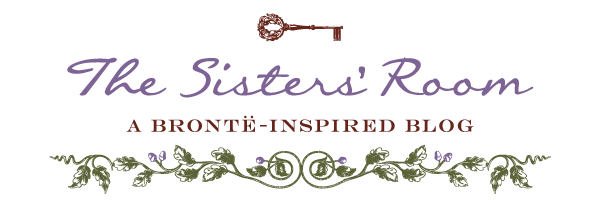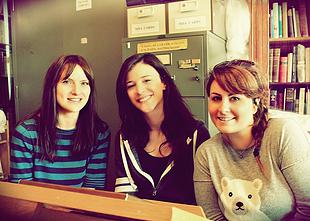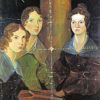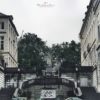During our second trip to Haworth, we met very nice people. One of them was a wonderful blue-eyed young woman called Sarah Laycock.  She was our guide in the Brontё Treasure Tour at the Parsonage, and she showed us some of the most incredible letters, manuscripts, drawings and personal possessions of the Brontё family with great passion.
She was our guide in the Brontё Treasure Tour at the Parsonage, and she showed us some of the most incredible letters, manuscripts, drawings and personal possessions of the Brontё family with great passion.
Being so close to the Brontёs was an unforgettable experience, and we learned a lot from Sarah. When she accepted to be interviewed for our blog we were so glad, and she gave us the opportunity to share with our readers the personal experience of a professional directly involved in the fascinating Brontё world. You can’t miss this interesting interview! Thank you again, Sarah!
What’s your job?
Library and Collections Officer at The Bronte Parsonage Museum.
When did you first “meet” the Brontes and who’s your favourite member of the family? Why?
I grew up in Haworth, so I have always been surrounded by the Bronte heritage. I started reading their novels at school and felt proud to have a shared sense of ‘place’ with the family. My favourite family member is Patrick Branwell, for the wasted talent and tragic life he led, he would have been so proud if he knew his ‘pillar’ portrait is now hanging in the National Portrait Gallery, London. There are many reasons why Branwell is my favourite, I could go on and on….
How long have you worked at the Parsonage and what’s the room you like the most? Why?
I’ve worked at the Parsonage for 8 years. My favourite room is Mr Bronte’s Bedroom, even though the bed is a reproduction, it still feels very atmospheric and eerie in there. The views from each of the windows in the house are important too, visitors can’t see out because the blinds are drawn during the day. I like to look out before we open to the public and see what the Bronte’s themselves would have seen.
Which are the Bronte treasures you love showing tourists the most?
This is a very difficult question! My absolute favourite item to show is the ‘Bells’ signatures, the only piece of paper which all three sisters have signed using their pseudonyms Currer, Ellis and Acton Bell. It was at the request of an autograph hunter, a man who bought one of the two copies sold of their collective Poems – a man with great insight, clearly. We even have the envelope it was sent in. This is very closely followed by the first Diary paper by Emily and Anne Bronte, 24th November 1834, the one where Emily poignantly predicts what her siblings will be doing in the year 1874: ‘in which year / I shall be in my 57th year / Anne will be going in her 55th / year Branwell will be going in / his 58th year and Charlotte / in her 59th year hoping we / shall all be well at that time / We close our paper.’ Although this can sometimes be difficult to read out, and I have been known to choke up a fair few times whilst showing this to visitors, embarrassingly. There are a handful of very poignant objects in the collection, this is one of them. I also love showing the pen and ink sketch called the Parody by Branwell, it’s very, very dark but has a great impact on visitors. The miniature ‘little books’ are also fabulous to show, again, they create an impact and a ‘wow’ factor because they are just so incredible to see. The first edition of Wuthering Heights, Emily’s burnt comb (the one she was supposedly holding when she died and it dropped in the fire) Anne’s last letter, and the famous ‘dreadful dream’ letter by Charlotte. This has to be one of the saddest letters she’s ever written and I challenge anyone to read it without getting emotional. You just have to look at her handwriting to get a sense of how she was feeling when she wrote this letter.
There are also some great doodles on the backs of drawings in the collection, which are difficult to display, so I show these to visitors during the treasures sessions. I feel closest to the Brontës when handling their personal possessions though; Branwell’s (empty) battered leather wallet, Charlotte’s glasses, her curling tongs, and her jewellery. The dried ink inside her paint box and the pencil just as sharp as it was the last time she used it all make me feel very close to her, and lucky to have my job.
How do you take care of the Bronte Collection and how do you preserve it during the Treasure Tour?
We keep all of our collection that isn’t on display in a very secure room which is monitored for temperature and humidity levels. Everything we use is acid-free; the mounts, the tissue, the cardboard folders, and the boxes they are stored in. We always use gloves when handling the collection and we rotate what items are displayed each year and what items we use for the ‘treasures’ sessions so that we aren’t using the same objects over and over again. Fortunately, we have the largest collection of Bronte material in the world so it’s a case of ‘take your pick’. The public can’t touch any of the items from the collection, as we have professional training to be able to do so. We also don’t allow the objects to be exposed to high light levels, so the blinds are drawn during the day throughout the museum.
01/09/2015
If you liked reading Sarah Laycock’s interview and want to know more about the people working at the Parsonage, read also Our Guest: Interview To Ann Dinsdale, Principal Curator at the Brontë Parsonage Museum





